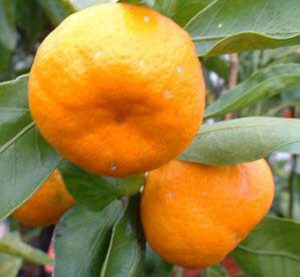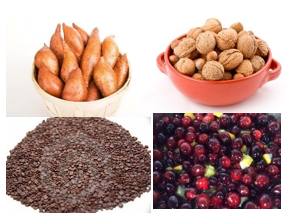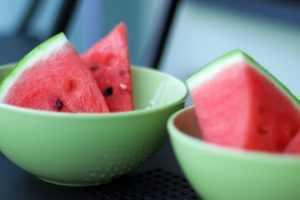by Laurie Osgood | Dec 3, 2016
 It’s the fall season, and Satsumas are hitting the shelves at your local grocery store. Satsumas are a seedless variety of the mandarin orange, and are harvested during the fall and early winter. Satsumas are grown in the cool, sub-tropical areas of California, Florida, Alabama, Louisiana, Mississippi and Texas. Because of their thin skin, satsumas are sweet and easy to peel. Whether you are buying satsumas from your local grocery store, farmers market or roadside stand, it is very important to purchase all of your citrus from a reputable vendor.
It’s the fall season, and Satsumas are hitting the shelves at your local grocery store. Satsumas are a seedless variety of the mandarin orange, and are harvested during the fall and early winter. Satsumas are grown in the cool, sub-tropical areas of California, Florida, Alabama, Louisiana, Mississippi and Texas. Because of their thin skin, satsumas are sweet and easy to peel. Whether you are buying satsumas from your local grocery store, farmers market or roadside stand, it is very important to purchase all of your citrus from a reputable vendor.
Satsuma Trees:
Satsuma trees are small to medium in size, and can easily tolerate the cooler fall temperatures that the Florida Panhandle is known for. Satsuma trees are relatively easy to grow and make an attractive addition to your home landscape. Picking fresh fruit off of your own tree provides a much fresher, and cost efficient treat. Satsuma trees are best started in a container and then transferred into the ground. When choosing a spot to plant a satsuma tree, remember that citrus trees need full sun.
 “Before planting any new plants, you should always conduct a soil sample, to determine if there are any issues in the soil where you will plan the satsuma tree” said DJ Wiggin, Small Farms Agent with the Florida A&M University Extension Program in Gadsden County. If you would like to request a soil sample test kit, you should contact your local UF/IFAS Extension office.
“Before planting any new plants, you should always conduct a soil sample, to determine if there are any issues in the soil where you will plan the satsuma tree” said DJ Wiggin, Small Farms Agent with the Florida A&M University Extension Program in Gadsden County. If you would like to request a soil sample test kit, you should contact your local UF/IFAS Extension office.
Fruit Bearing Season:
Satsuma oranges have a relatively brief fruit bearing season, between October and December. This short season give the satsuma oranges their rich flavor. A few nights with temperatures that drop into the 40s, help improve their sweetness. However, the fruit of the satsuma tree should be picked promptly when ripe, because the heavy fruit could cause damage to some weaker limbs of the tree.
According to DJ Wiggins, “When properly stored, satsumas have a shelf life of several weeks”. Satsuma oranges can be juiced, eaten as a snack, or used in recipes, including Orange marmalade.
Recipe Source: Adapted from So Easy to Preserve, from the Cooperative Extension at The University of Georgia.
Orange Marmalade
Yields about 7 half-pint jars
• 4 cups thinly slices Orange Peel (about 6 large oranges or 32 Satsumas)
• 4 cups Orange Pulp, cut up (about 6 large oranges or 32 Satsumas)
• 1 thinly sliced Lemon (about 2 medium)
• 6 cups of Water
• Sugar (about 6 cups)
Directions:
To Prepare the Fruit- Add water and fruit together in a saucepan. Heat to simmer for 5 minutes. Cover and let stand 12 to 18 hours in refrigerator. Heat and cook over medium heat until peel is tender, about 1 hour. (Note: When peeling citrus fruits for marmalades, be sure to include some of the white membrane found just under the skin. This is where most of the pectin is located.)
To Make Marmalade– Sterilize canning jars. Measure fruit and liquid. Add 1 cup sugar for each cup of fruit mixture. Bring slowly to boil, stirring until sugar dissolves. Cook rapidly to the jellying point (25 minutes), stirring occasionally. Pour hot marmalade into hot, sterile ½ pint jars, leaving ¼ inch headspace. Wipe jar rims with a dampened clean paper towel and adjust lids. Process 5 minutes in a Boiling Water Canner.
Interested in Learning More about Canning Fruits and Vegetables? The Gadsden County Extension Program offers Water Bath Canning Classes throughout the year, to learn more, call us at (850) 875-7255.
Resources:
University of Florida IFAS Extension. The Satsuma Mandarin, Peter C. Andersen and James J. Ferguson, Revised November 2015
http://edis.ifas.ufl.edu/pdffiles/CH/CH11600.pdf
University of Alabama Extension, Satsuma Season: Enjoying the Christmas Orange, James Miles and Emma Sager, November 10, 2014
http://news.aces.edu/blog/2014/11/10/satsumaseason/
University of Georgia Extension: Citrus Fruit for Southern and Coastal Georgia, Krewer and Powell, Extension Fruit Specialists.
http://extension.uga.edu/publications/detail.cfm?number=B804
Recipe: Reynolds, Susan, Paulette Williams, Judy A. Harrison, and Susan J. Reynolds. So Easy to Preserve. Athens: Cooperative Extension Service, U of Georgia, College of Family and Consumer Sciences, College of Agricultural and Environmental Sciences, 2006. Page 218
The Institute of Food and Agricultural Sciences (IFAS) is an Equal Opportunity Institution authorized to provide research, educational information and other services only to individuals and institutions that function with non-discrimination with respect to race, creed, color, religion, age, disability, sex, sexual orientation, marital status, national origin, political opinions or affiliations. For more information on obtaining other UF/IFAS Extension publications, contact your county’s UF/IFAS Extension office.
U.S. Department of Agriculture, UF/IFAS Extension Service, University of Florida, IFAS, Florida A & M University Cooperative Extension Program, and Boards of County Commissioners Cooperating. Nick T. Place, dean for UF/IFAS Extension.
Coauthors:
Laurie Osgood, Family and Consumer Science Agent, UF/IFAS Extension, Gadsden County
DJ Wiggins, Small Farms Agent, Florida A&M University Extension, Gadsden County
by Ginny Hinton | Nov 25, 2016
As we head into the season of overindulgence, it’s good to know that some holiday “treats” can actually be nutritiously guilt-free if we eat them in moderation. Read on to find the hidden health benefits of some classic favorites.
Sweet Potatoes: Sure, it’s a no-brainer that sweet potatoes are a source of vitamins, but these super veggies may be even better for you than you think! Your body converts the alpha and beta carotene from sweet potatoes into Vitamin A, helping keep your eyes, bones and immune system in top shape. Choose firm sweet potatoes with tapered ends and a uniform shape and color.
 Nuts: Even though nuts are high in calories and fat, they are loaded with vitamins and minerals. The fat in nuts is heart-healthy. In fact, research suggests that eating just a handful of nuts a few times a week may lower heart disease risk. Nuts are also a great source of antioxidants, energy and protein. You might consider nuts a Christmas gift to your body!
Nuts: Even though nuts are high in calories and fat, they are loaded with vitamins and minerals. The fat in nuts is heart-healthy. In fact, research suggests that eating just a handful of nuts a few times a week may lower heart disease risk. Nuts are also a great source of antioxidants, energy and protein. You might consider nuts a Christmas gift to your body!
Cocoa: Who doesn’t love a steaming cup of hot cocoa? Now, we know that its health benefits give us even more reason to love it. For example, cocoa contains antioxidants called flavonoids that may lower the risk of heart attack or stroke. Dark chocolate with a high percent of cocoa solids may help lower blood pressure, improve blood vessel health, and regulate cholesterol levels. So, give in to your craving – in moderation, of course!
Cranberries: With their rich red color, cranberries add a festive touch to any holiday table. Beautiful cranberries contain only 45 calories per cup while offering a healthy dose of benefits. They’re a good source of vitamin C and fiber, and they outrank nearly every other fruit and vegetable in the amount of disease fighting antioxidants they contain. Buy cranberries fresh in fall and winter and store them in a tightly sealed bag in your refrigerator to keep them fresh longer.
References:
EatingWell. Surprisingly Healthful Seasonal Treats. http://recipes.millionhearts.hhs.gov/articles/surprisingly-healthful-seasonal-treats
Hendrick, Bill. Cocoa Rich in Health Benefits. WebMD Health News. March 23,2011. http://www.webmd.com/diabetes/news/20110323/cocoa-rich-in-health-benefits
Lerch Davis, Jeanie. Cranberries, Year-round Superfood. Web MD Feature. 9/29/2009. www.webmd.com/food-recipes/features/cranberries-year-round-superfood.
Mayo Clinic Staff. Nuts & your heart: Eating nuts for heart health. 9/15/2016. www.mayoclinic.org.

by Dorothy C. Lee | Jun 29, 2016
 A busy schedule is the most used excuse for not eating nutritiously. When pressed for time, it’s easy to fall into the habit of making unhealthy food choices.
A busy schedule is the most used excuse for not eating nutritiously. When pressed for time, it’s easy to fall into the habit of making unhealthy food choices.
For those who have no time to prepare meals during the work day, yet want to eat nutritiously, one solution is to plan ahead and prepare mini meals and snacks that can be eaten at any time. Not only will this save money, it will help guard against that temptation of vending machines or fast food. Several snacks spaced throughout the day can take the place of several meals. Snacks also help curb between-meal hunger. Snacking is a great solution as long as you don’t forget to make healthy choices.
Here are some tips for preparing nutritious on-the-go meals and snacks:
Planning Ahead
- Your food choices will depend partly on the facilities available where you work. If there is a refrigerator, food selection can be more varied and a microwave is a plus.
- Plan a week’s worth of snacks. Add these food items to your weekly shopping list.
- Invent ways to use leftovers in snacks. Be creative!
- Prepare and pack the food the night before if your mornings are hectic.
- Create a mess kit to keep at your desk. Include a can opener, mug, plate, utensils, and napkins. Paper plates and plastic utensils make clean-up easy.
Pack It Up at Home
- Invest in a selection of small plastic containers that can be easily packed into an insulated lunch bag. These are usually inexpensive.
- Use insulated containers to keep hot foods hot and cold foods cold.
- Purchase a selection of plastic bags with a variety of seals. Also, have aluminum foil and plastic wrap available.
Snacking by Food Group
- Meat, Poultry, Fish and Alternatives – Try individual-sized cans of fish and chicken; hard cooked eggs; peanut butter; unsalted nuts; cooked, dried peas and beans in salads; and leftover cooked meats and poultry in sandwiches and salads.
- Dairy – Include low fat-yogurt and yogurt drinks in convenient serving size containers, low-fat cottage cheese, skim milk, low- fat milk, and individually wrapped cheeses. You can satisfy a sweet craving with individual servings of ready-made pudding or a flavored cheese.
- Grains – For convenience, include individual serving size boxes of cereal. Choose cereals low in sugar. Select enriched whole grain breads, rolls, crackers, and pita bread. Whole grain or enriched cookies or muffins are a nutritious choice for something sweet.
- Fruits/Vegetables – Fruits are a natural to pack since many come in their own package – for instance, bananas, grapes, oranges, apples and pears. Dried fruits now are available in serving size packets. You also can buy them in bulk and make your own packets.
- Vegetables – Fresh vegetables make great crunchy snacks. Serve with a yogurt- or cottage cheese-based dip, or tossed with a vinaigrette as a vegetable salad.
- Munchies/Combos – Mix plain yogurt with fresh fruits or dry whole grain cereal.
- Trail mix in individual serving size packets travels well. Make your own with dried fruits, unsalted nuts, seeds, and cereals.
- Stuff celery with peanut butter or farmer cheese mixed with raisins.
- Mix salads with cottage cheese and chopped fresh fruits or vegetables.
- Try individual serving size packets of whole grain chips, potato chips, and pretzels.
- Snacks You Can Keep in Your Desk Drawer – Keep a supply of emergency rations such as peanut butter, whole grain crackers, nuts, dark chocolate, and raisins available for days when you forget lunch and just cannot get out.
Munching on this combination during the day may help you resist turning in at the first fast food place you pass on the way home!
by Amy Mullins, PhD, RDN | May 30, 2016
It’s hard to believe that summer is almost here and the kids are out of school! Often times, when kids (and parents too) get away from their normal routine, poor eating and snacking habits creep in. It’s important for kids (and parents) to have a variety of go-to snacks that are tasty, healthy, and easy to prepare!
Put some thought into which snacks make the best choices, and get input from the kids. Children and teenagers are more likely to eat what you buy (and be excited about it!), if they help in the process.
 1.) PLAN: Sit down together and make a list of snack-type foods they might like, and can easily prepare themselves.
1.) PLAN: Sit down together and make a list of snack-type foods they might like, and can easily prepare themselves.
2.) LIST: Make a list of the foods you’ll need to pick up at the grocery store.
3.) SHOP: Take the kids with you shopping… let them help fill the cart with the foods you’ve agreed on.
4.) PREPARE: Allow the kids to help wash, cut, portion, and prepare snacks. This will give them more confidence in the kitchen… now and as a future adult.
Stumped on where to get started? Your best bet is to stay away from processed, pre-packaged snack foods, and sugary drinks. These are typically high in unhealthy fats, oils, and sugar, and lack the vitamins, minerals, and fiber fresh and frozen whole foods have.
Try these super easy and healthy snacks:
- Layer vanilla yogurt and mandarin oranges or blueberries in a tall glass. Top with a sprinkle of granola to make a “parfait”.
- Put cubes of low-fat cheese and grapes on pretzel sticks to make “snack-kabobs”.
- Top a banana with low-fat vanilla and strawberry frozen yogurt and sprinkle with your favorite whole-grain cereal for a healthy “banana-split”.
- Use whole grain (flour or corn) tortillas and top with tomato sauce, cut veggies and shredded cheese. Eat it flat (like a pizza) or roll it up (like a wrap).
Keep your children, and yourself, on track this summer by remembering these main messages from ChooseMyPlate and The Dietary Guidelines:
- Make half your plate fruits and vegetables.
- Focus on whole fruits.
- Vary your veggies.
- Make half your grains whole grains.
- Move to low-fat and fat-free milk or yogurt.
- Vary your protein routine.
- Drink and eat less sodium, saturated fat, and added sugars.
Everything you eat and drink over time matters. The right mix can help you be healthier now and in the future. Start with small changes to make healthier choices you can enjoy. Find your healthy eating style and maintain it for a lifetime.
Find more great ideas with additional resources from MyPlate Snack Tips for Parents
and The Academy of Nutrition and Dietetics 25 Healthy Snacks for Kids.

by Shelley Swenson | Jan 15, 2016
 Valentine’s Day and chocolate just go together! Can you really have one without the other? I crave chocolate all year round and with some of the recent research I have read, I can feel all right about giving in.
Valentine’s Day and chocolate just go together! Can you really have one without the other? I crave chocolate all year round and with some of the recent research I have read, I can feel all right about giving in.
A recent study reported in the American Journal of Clinical Nutrition tested the effects of dark and white chocolate on healthy adults to determine whether either type played a role in blood pressure and insulin sensitivity. They concluded that dark chocolate can indeed help reduce blood pressure and insulin resistance. White chocolate did not provide these health benefits.
Keep in mind that although dark chocolate has health benefits, most chocolate bars are high in saturated fat, so moderation is key. Eating dark chocolate cannot substitute for everyday healthy food choices. Nor can chocolate replace regular exercise or medications that have been prescribed by your physician. It is so nice to know you can indulge in your Valentine’s Day chocolate, in moderation, without feeling guilty about it if you choose the dark.
 It’s the fall season, and Satsumas are hitting the shelves at your local grocery store. Satsumas are a seedless variety of the mandarin orange, and are harvested during the fall and early winter. Satsumas are grown in the cool, sub-tropical areas of California, Florida, Alabama, Louisiana, Mississippi and Texas. Because of their thin skin, satsumas are sweet and easy to peel. Whether you are buying satsumas from your local grocery store, farmers market or roadside stand, it is very important to purchase all of your citrus from a reputable vendor.
It’s the fall season, and Satsumas are hitting the shelves at your local grocery store. Satsumas are a seedless variety of the mandarin orange, and are harvested during the fall and early winter. Satsumas are grown in the cool, sub-tropical areas of California, Florida, Alabama, Louisiana, Mississippi and Texas. Because of their thin skin, satsumas are sweet and easy to peel. Whether you are buying satsumas from your local grocery store, farmers market or roadside stand, it is very important to purchase all of your citrus from a reputable vendor. “Before planting any new plants, you should always conduct a soil sample, to determine if there are any issues in the soil where you will plan the satsuma tree” said DJ Wiggin, Small Farms Agent with the Florida A&M University Extension Program in Gadsden County. If you would like to request a soil sample test kit, you should contact your local UF/IFAS Extension office.
“Before planting any new plants, you should always conduct a soil sample, to determine if there are any issues in the soil where you will plan the satsuma tree” said DJ Wiggin, Small Farms Agent with the Florida A&M University Extension Program in Gadsden County. If you would like to request a soil sample test kit, you should contact your local UF/IFAS Extension office.





